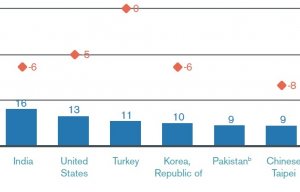
World textile and apparel exports fall in 2016
Looking to international trade, the evolution was undoubtedly disappointing in 2016.

21st December 2017
Innovation in Textiles
|
Brussels
 Looking to international trade, the evolution was undoubtedly disappointing in 2016. According to the WTO World Trade Statistical Review 2017, the ratio of international trade growth to GDP growth fell to 0.6, representing the worst year since 2001, and growth was just 1.3% in volume terms – the weakest growth rate since 2008.
Looking to international trade, the evolution was undoubtedly disappointing in 2016. According to the WTO World Trade Statistical Review 2017, the ratio of international trade growth to GDP growth fell to 0.6, representing the worst year since 2001, and growth was just 1.3% in volume terms – the weakest growth rate since 2008.
Despite a brightening of the EU economy, textiles and clothing activity in the EU lost dynamism in particular towards the end of the year, Euratex, the European Apparel and Textile Confederation, reports.
According to the latest bulletin released by the textiles group, textiles and clothing moved in opposite directions: textiles activity improved to some extent, while activity in the clothing industry showed no signs of recovery. Last year saw the slowest growth in EU exports since the financial crisis, while the retail turnover development was less dynamic than in previous year, recording a modest growth.
In spite of political concerns, the overall situation of the EU and the OECD countries continued to improve. The EU's economic improvement did not, however, benefit the clothing sector, whilst the textiles sector edged ahead by just 1.6%. Production prices again fell across the EU as a whole, with an overall reduction of 1.1%. The only exception was in the UK, where output prices rose. However, this represented a lesser decline than in 2015.
The EU-28 turnover index for the clothing sector surpassed the 2010 threshold, up by 0.8%. The index for textiles reached a new high in 2016 at 107.5, compared to 105.5 points in 2015 – an increase of 1.9%. In the EU as a whole, investment only grew very slightly in 2016, taking into account the time lag between investment decisions and their implementation. Besides, Switzerland and Turkey faced declines in both sectors.
“Employment in the EU for both the textiles and clothing sectors remained almost stable in 2016. Taking into account the need to increase productivity to contend with global competition, as well as consumer confidence that only appeared late in the year, we could definitely view this general trend as a real sign of resilience,” says Euratex. “The textiles sector was in a more robust position, enabling it to boost employment, whereas the clothing sector again declined.”
The outlook for the global economy both in 2017 and 2018 is somewhat favourable notwithstanding some continuing uncertainty, in particular, related to the trade policy of the US and the effects of Brexit, especially on exchange rates. Prices are rising, but quite slowly. This is also true for the costs of energy and certain raw materials.
The preliminary data for the first quarters of 2017 was also favourable for the textile sector, albeit with decline in the traditional sectors of spinning and weaving, as well as nonwovens, whilst finishing has recovered somewhat. Knitted items (circular knitting) continued to grow, but at a reduced pace. Other textiles, including technical textiles, expanded more sustainably. The growth observed mainly came from the Eastern European countries.
The clothing sector continued to cut production, yet turnover rose slightly. However, managers’ expectations during the second half of 2017 continued to rise in the clothing industry with positive assessments of production expectations.

Business intelligence for the fibre, textiles and apparel industries: technologies, innovations, markets, investments, trade policy, sourcing, strategy...
Find out more